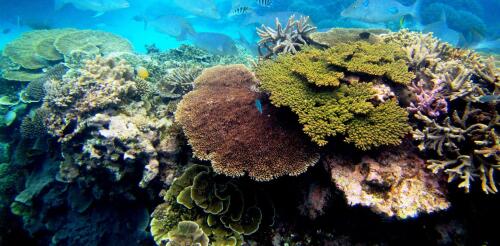Ocean acidification
Coral reefs are some of the oldest, most diverse ecosystems on Earth, and among the most valuable. They nurture 25% of all ocean life, protect coasts from storms and add billions of dollars yearly to the global economy through their influences on fisheries, new pharmaceuticals, tourism and recreation. Today, the world’s coral reefs are degrading at unprecedented rates due to pollution, overfishing and destructive forestry and mining practices on land. Climate change driven by human activities is warming and acidifying the ocean, triggering what could be the largest coral bleaching event on record. Under these combined pressures, scientists project that most corals could go extinct within a few generations. I am a marine biologist at the Smithsonian’s National Zoo and Conservation Biology Institute. For 17 years, I have worked with colleagues to create a global science program called the Reef Recovery Initiative that aims to help save coral reefs by using the scienc...
Most people associate hurricanes with high winds, intense rain and rapid flooding on land. But these storms can also change the chemistry of coastal waters. Such shifts are less visible than damage on land, but they can have dire consequences for marine life and coastal ocean ecosystems. We are oceanographers who study the effects of ocean acidification, including on organisms like oysters and corals. In a recent study, we examined how stormwater runoff from Hurricane Harvey in 2017 affected the water chemistry of Galveston Bay and the health of the bay’s oyster reefs. We wanted to understand how extreme rainfall and runoff from hurricanes influenced acidification of bay waters, and how long these changes could last. Our findings were startling. Hurricane Harvey, which generated massive rainfall in the Houston metropolitan area, delivered a huge pulse of fresh water into Galveston Bay. As a result, the bay was two to four times more acidic than normal for at least three...
Deep below the ocean surface, the light fades into a twilight zone where whales and fish migrate and dead algae and zooplankton rain down from above. This is the heart of the ocean’s carbon pump, part of the natural ocean processes that capture about a third of all human-produced carbon dioxide and sink it into the deep sea, where it remains for hundreds of years. There may be ways to enhance these processes so the ocean pulls more carbon out of the atmosphere to help slow climate change. Yet little is known about the consequences. Peter de Menocal, a marine paleoclimatologist and director of Woods Hole Oceanographic Institution, discussed ocean carbon dioxide removal at a recent TEDxBoston: Planetary Stewardship event. In this interview, he dives deeper into the risks and benefits of human intervention and describes an ambitious plan to build a vast monitoring network of autonomous sensors in the ocean to help humanity understand the impact. First, what is ocean carbon...
Heat waves, droughts and extreme weather are endangering people and ecosystems somewhere in the world almost every day. These extremes are exacerbated by climate change, driven primarily by increasing emissions of greenhouse gases that build up in the atmosphere and trap heat at the Earth’s surface. With that in mind, researchers are exploring ways to pull carbon dioxide out of the atmosphere and lock it away – including using the ocean. But while these techniques might work, they raise serious technical, social and ethical questions, many of which have no clear answers yet. We study climate change policy, sustainability and environmental justice. Before people start experimenting with the health of the ocean, there are several key questions to consider. Ocean carbon dioxide removal 101 The ocean covers about 70% of the planet, and it naturally takes up carbon dioxide. In fact, about a quarter of human-produced carbon dioxide ends up in the ocean. Ocean carbon di...



